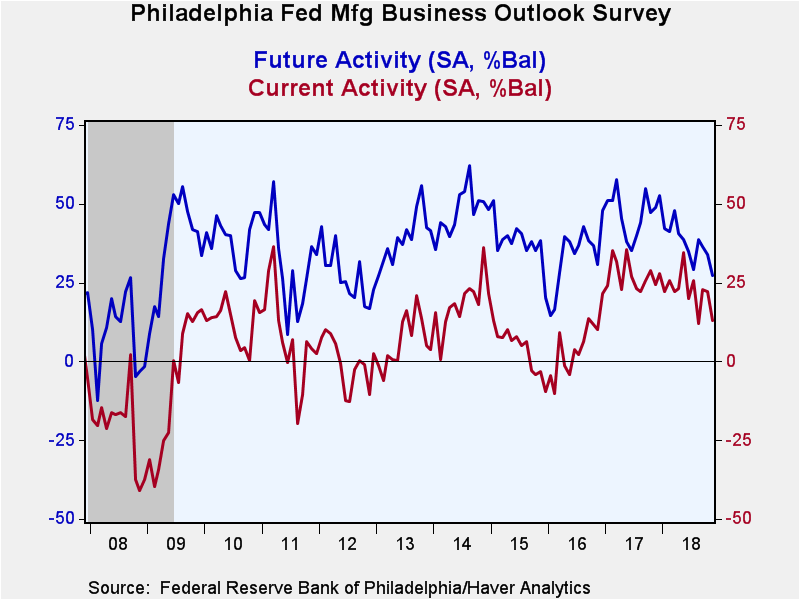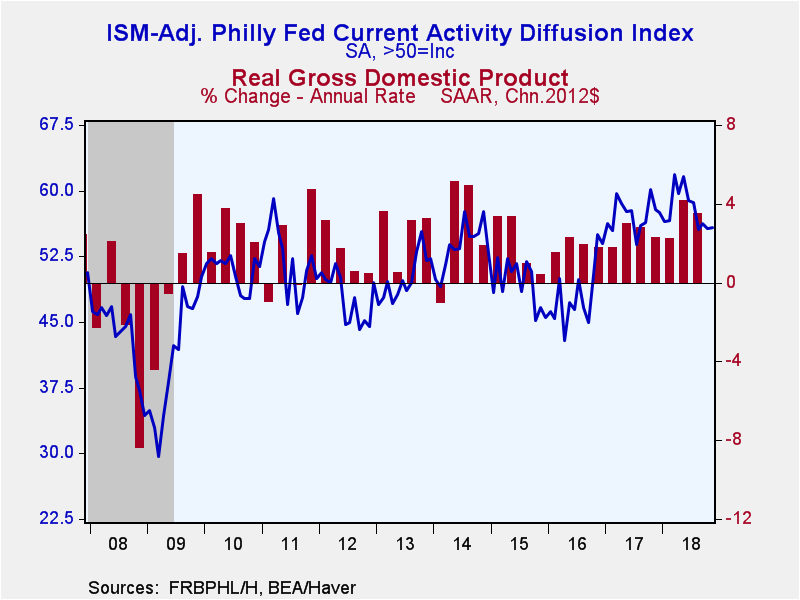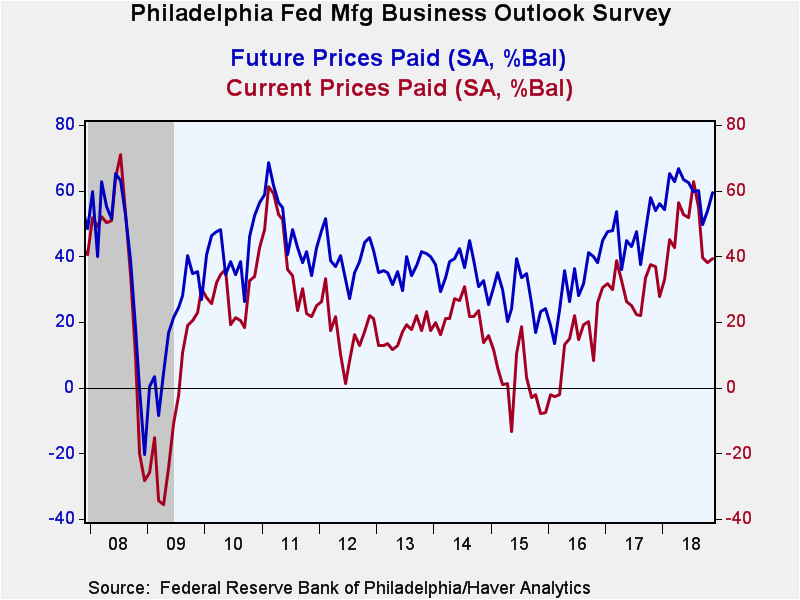 Global| Nov 15 2018
Global| Nov 15 2018Philadelphia Fed Manufacturing Drops; Pricing Pressures Stabilize
Summary
The Philadelphia Federal Reserve reported that its General Factory Sector Business Conditions Index declined more than expected to 12.9 in November from 22.2 in October. The Action Economics Forecast Survey median was 21.0. These [...]
The Philadelphia Federal Reserve reported that its General Factory Sector Business Conditions Index declined more than expected to 12.9 in November from 22.2 in October. The Action Economics Forecast Survey median was 21.0. These figures are diffusion indexes where readings above zero indicate expansion. The percentage of firms reporting an improvement in business activity fell to 34.5%, down from the high of 48.2% in May of last year. The number reporting a weakening environment rose to 21.6%, the highest reading since August 2016.
Haver Analytics constructs an ISM-Adjusted General Business Conditions Index which edged up to 55.8 in November from 55.7 in October. This measure hit a cycle high of 61.9 in March. During the last ten years, there has been a 65% correlation between the quarterly ISM-adjusted Philadelphia Fed Index and quarterly real GDP growth.
The gap between the headline and ISM-Adjusted index is indicative of the mixed readings from the individual business indicators. New orders fell to their lowest level since September 2016. Shipments and employment also declined, though less dramatically than orders. Meanwhile, inventories rose and delivery times slowed. Unfilled orders, which is not part of the ISM-Adjusted measure, declined to its lowest level in over two years.
Regarding employment, during the last ten years there has been a 79% correlation between the employment index and the month-to-month change in factory sector payrolls. Twenty-five percent of respondents reported increased hiring, down from 30%, while eight percent indicated a decrease, down from 11%. The index of future employment rose in November, but remained well below its May high. The average workweek reading fell to its lowest level since late-2016.
Pricing pressures seem to have stabilized with both prices paid and received indexes relatively unchanged over the last three months. Forty-one percent of firms reported higher prices paid in November, down from 63.1% in August. Just 2.1% indicated falling prices, though this is up from July's reading of 0%. In contrast, the index of future prices paid increased.
The index measuring expectations of future business conditions fell to 27.2, the lowest reading since February 2016. However, businesses anticipated improved orders, shipments, unfilled orders, capital spending and slower delivery times. Inventories are expected to decline.
The survey panel consists of 150 manufacturing companies in the third Federal Reserve District (which consists of southeastern PA, southern NJ and Delaware). The diffusion indexes represent the percentage of respondents indicating an increase minus the percentage indicating a decrease in activity. The ISM-adjusted figure, calculated by Haver Analytics, is the average of five diffusion indexes: new orders, shipments, employment, delivery times and inventories with equal weights (20% each). Each ISM-adjusted index is the sum of the percent responding "higher" and one-half of the percent responding "same."
The figures from the Philadelphia Federal Reserve dating back to 1968 can be found in Haver's SURVEYS database. The expectation from the Action Economics Forecast Survey is available in AS1REPNA.
| Philadelphia Fed - Manufacturing Business Outlook Survey (%, SA) | Nov | Oct | Sep | Nov'17 | 2017 | 2016 | 2015 |
|---|---|---|---|---|---|---|---|
| General Factory Sector Business Conditions | 12.9 | 22.2 | 22.9 | 24.3 | 27.4 | 4.9 | 3.7 |
| ISM-Adjusted Business Conditions | 55.8 | 55.7 | 56.3 | 57.8 | 57.2 | 48.3 | 49.4 |
| New Orders | 9.1 | 19.3 | 21.4 | 24.2 | 25.4 | 4.9 | 3.0 |
| Shipments | 21.6 | 24.5 | 19.6 | 23.8 | 26.8 | 6.9 | 3.0 |
| Unfilled Orders | -4.8 | -2.3 | 12.6 | 16.6 | 11.9 | -5.6 | -5.1 |
| Delivery Time | 5.0 | 0.2 | 11.1 | 15.2 | 10.6 | -4.6 | -4.2 |
| Inventories | 9.5 | -0.8 | -3.5 | -5.5 | 2.8 | -9.6 | -1.4 |
| Number of Employees | 16.3 | 19.5 | 17.6 | 22.1 | 16.2 | -5.6 | 3.9 |
| Average Workweek | 6.3 | 20.8 | 14.6 | 14.9 | 14.9 | -5.4 | -1.7 |
| Prices Paid | 39.3 | 38.2 | 39.6 | 36.9 | 30.4 | 13.5 | 1.5 |
| Expectations - General Business Conditions; Six Months Ahead | 27.2 | 33.8 | 36.3 | 48.7 | 47.1 | 33.7 | 37.6 |
Gerald D. Cohen
AuthorMore in Author Profile »Gerald Cohen provides strategic vision and leadership of the translational economic research and policy initiatives at the Kenan Institute of Private Enterprise.
He has worked in both the public and private sectors focusing on the intersection between financial markets and economic fundamentals. He was a Senior Economist at Haver Analytics from January 2019 to February 2021. During the Obama Administration Gerald was Deputy Assistant Secretary for Macroeconomic Analysis at the U.S. Department of Treasury where he helped formulate and evaluate the impact of policy proposals on the U.S. economy. Prior to Treasury, he co-managed a global macro fund at Ziff Brothers Investments.
Gerald holds a bachelor’s of science from the Massachusetts Institute of Technology and a Ph.D. in Economics from Harvard University and is a contributing author to 30-Second Money as well as a co-author of Political Cycles and the Macroeconomy.









